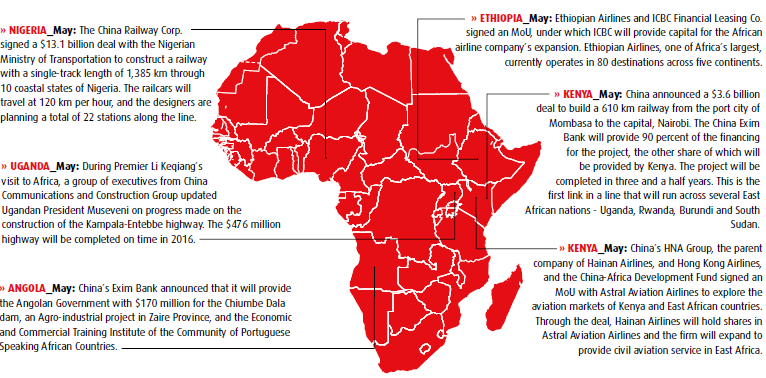|

Growth Stabilizes
Despite continued distortion in trade data evaluation due to the propensity for fraudulent “over-invoicing” in the first half of last year, trade figures surprised analysts by rising in April.
Trade growth focused on the U.S. and EU
Largely as a result of trade with developed markets, both exports and imports increased in April. Exports increased from $170 billion in March to $188 billion in April, a 9-percent year-on-year increase. Imports, on the other hand, experienced 8-percent growth from $162 to $170 billion.
Much of the growth in exports was directed toward developed countries. Exports registered to the United States, for example, jumped 12 percent in April from the previous year, a significant development considering the 11.3-percent decrease year-on-year in February and the 1.2-percent increase in February. An impressive 15.1-percent increase in shipments to the European Union occurred in April, compared to the same period in 2013. Exports to ASEAN, on the other hand, fell to 3.8-percent growth from double-digit growth earlier in the year. Some analysts contend that the lackluster demand in emerging economies suggests that this trade growth does not mean that exports are necessarily en route to recovery.
Prices flatten
The simultaneous decrease of CPI and PPI over April is a sign of weak demand for consumption and investment and slowing economic growth. Food prices, a key contributor to the decrease in consumer and producer prices, increased by only 2.3 percent in April, falling under the 4.1-percent increase in March. The price of pork and fresh vegetables, for example, fell by 7.2 percent and 7.9 percent, respectively. Analysts suggest that there is downward pressure on property prices, and that there will be room for policy intervention, such as cutting the reserve-requirement ratio, if real estate prices continue to fall.
Sign of stabilization in future growth
Some analysts suggest that trade figures will continue to increase in May and that this sustained growth will encourage Chinese policymakers to reverse the recent depreciation of the yuan. Over the first four months of 2014, fixed-asset investment growth had fallen to 17.3 percent, which demonstrates a potential for lower future economic growth, despite the encouraging signs from trade data.

The Evolving Nature of Sino-African Diplomacy
China’s Premier Li Keqiang embarked on a tour across the African nations of Ethiopia, Nigeria, Angola and Kenya, four of the most important hotspots of Sino-African relations. This visit marked the first trip that Li has made to Africa since his assumption of the position of prime minister in 2013.
In addition to making high-level visits with local political leaders, Li delivered a special address at the Plenary Session of the World Economic Forum on Africa in Abuja, Nigeria. As the Chinese Government announced various cooperative deals, the Xi Jinping and Li Keqiang led leadership leveraged this trip to publicize its understanding of the Sino-African relationship and where it seeks to steer this increasingly important relationship.
Li’s visit marks an evolution in the nature of the Sino-African relationship. The value of Sino-African trade reached over $210 billion in 2013, and China has been Africa’s largest trading partner for the past five years. The scale of African trade is only representative of the increasingly “deep” nature of the Sino-African exchange. While the traditional natural resources sectors in which China has engaged with Africa, such as petroleum products and minerals, will continue to be a key area of Sino-African cooperation, China has increasingly invested in a diverse group of sectors in Africa, from the spread of African media enterprises to the development of modern transportation infrastructure in Africa.
While some analysts have asserted that these investments merely provide a route for which China can more efficiently extract resources, in fact, many of China’s investments will allow for greater intra-African integration. For example, China recently announced that it will provide 90 percent of the financing for the 610-km Mombasa-Nairobi railway in Kenya, which will eventually extend across East Africa, from South Sudan through Uganda, Rwanda and Burundi to the coast of Kenya.
Another major collaborative development representing the direction of future Sino-African relations was announced for East Africa during Li’s visit. Hainan Airlines, Hong Kong Airlines, and the China-Africa Development Fund signed a Memorandum of Understanding with Astral Aviation Airlines, a Kenyan cargo-based airline, to explore the civil aviation sector in East Africa. Under the agreement, Astral will expand to provide civil aviation service across East Africa.
China is also deliberately “softening” the types of engagements it is undertaking in Africa in response to accusations of neocolonial behavior there. Chinese political leaders, for example, have recently begun embarking on their diplomatic activities alongside their wives.
China’s increasing level of development aid provides a more concrete example of China’s increasing soft-power relationship with Africa. China will engage with Africa in the Africa Talent Program, which will train 30,000 African technicians and professionals in various sectors.
These developments are representative of China’s long-term commitment to South-South cooperation and a thorough multi-faceted engagement with the African continent. As the Sino-African relationship deepens, spreads and grows, it will undoubtedly encounter growing pains, but China’s demonstrated commitment to this dynamic means that it is likely to only grow in importance on the global scale of political and business affairs.
The ChinAfrica Econometer is produced by The Beijing Axis, a China-focused international advisory firm operating in four principal areas: Commodities, Capital, Procurement, and Strategy.
For more information, please contact:
Barbie Co at barbieco@thebeijingaxis.com
www.thebeijingaxis.com |